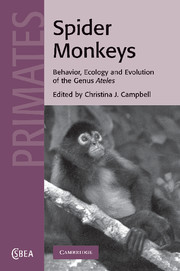Book contents
- Frontmatter
- Contents
- List of contributors
- Acknowledgements
- 1 Introduction
- Part I Taxonomy, phylogeny and evolution
- Part II Ecology
- Part III Behavior and reproduction
- Part IV Interactions with humans
- 13 Spider monkey conservation in the twenty-first century: recognizing risks and opportunities
- 14 The ethnoprimatology of spider monkeys (Ateles spp.): from past to present
- Index
- References
13 - Spider monkey conservation in the twenty-first century: recognizing risks and opportunities
Published online by Cambridge University Press: 05 May 2010
- Frontmatter
- Contents
- List of contributors
- Acknowledgements
- 1 Introduction
- Part I Taxonomy, phylogeny and evolution
- Part II Ecology
- Part III Behavior and reproduction
- Part IV Interactions with humans
- 13 Spider monkey conservation in the twenty-first century: recognizing risks and opportunities
- 14 The ethnoprimatology of spider monkeys (Ateles spp.): from past to present
- Index
- References
Summary
Introduction
Spider monkeys (Ateles spp.) occur from southeastern Mexico to the southern Amazonia rain forests of central Bolivia and western Brazil (Kellogg and Goldman, 1944; Hall, 1981; Collins and Dubach, 2000a; Wilson and Reeder, 2005). As with many species from tropical forests, their range has been decreasing as these ecosystems are transformed. This is very clear if we compare the distributions published by Kellogg and Goldman (1944) and by Collins and Dubach (2000a). A decrease in the distribution range of all species of Ateles during this period suggests that the numbers of all the taxa are declining. However, there are important differences among the taxa in their current distribution range, as well as in the magnitude and causes of the decline in population size.
When reviewing the conservation status of spider monkeys across their current range, the taxonomy of the group must be considered. In this volume, the Collins and Dubach (2000b) taxonomy has been adopted, which recognizes three distinct species of spider monkeys: Ateles paniscus, A. belzebuth, and A. geoffroyi (with a possible fourth species A. hybridus – see also Collins, this volume). Other authors (Groves, 1989; Iracilda da Cunha Sampaio et al., 1993; Rylands et al., 2001) have recognized as many as six distinct species with A. chamek, A. hybridus and A. marginatus all upgraded from belzebuth subspecies status. As a conservative approach and for the purposes of conservation planning, we prefer to analyze at the subspecies level thereby recognizing all 16 distinct taxa (Table 13.1).
- Type
- Chapter
- Information
- Spider MonkeysThe Biology, Behavior and Ecology of the Genus Ateles, pp. 351 - 376Publisher: Cambridge University PressPrint publication year: 2008
References
- 21
- Cited by

